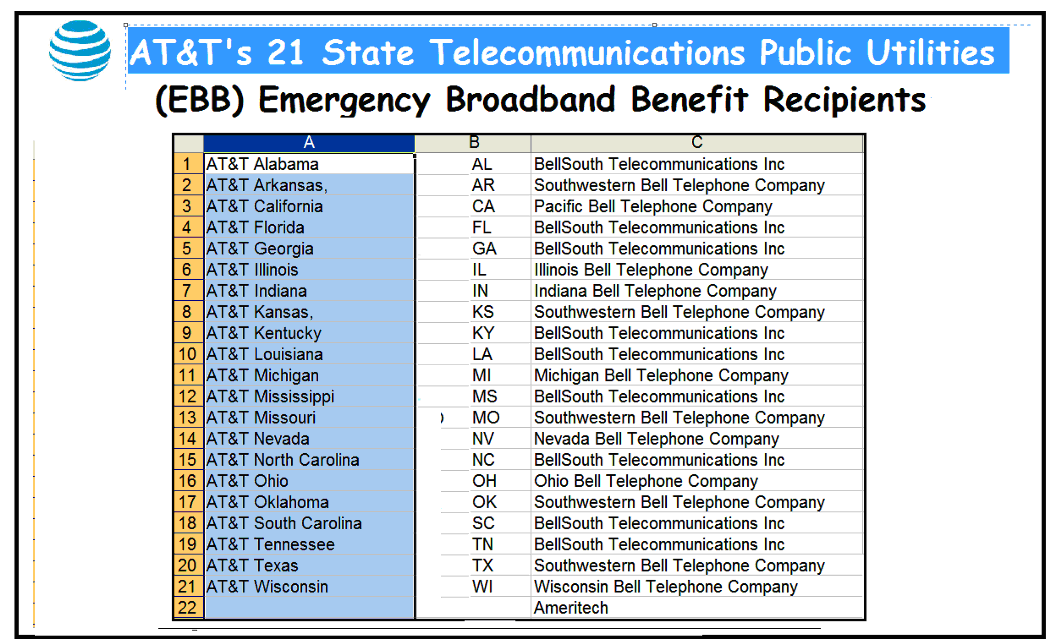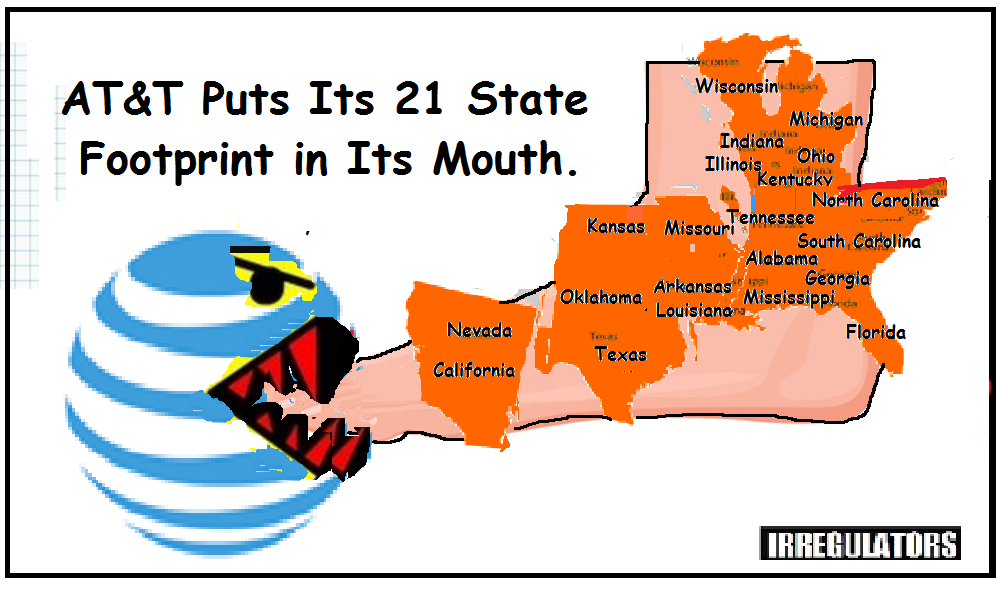 By B.N. Frank
By B.N. Frank
The Federal Communications Commission (FCC) is supposed to protect Americans by regulating the telecom industry. Instead it has catered to the industry for decades, thus being labeled a “captured agency” (see 1, 2). Numerous lawsuits have been filed against the FCC because of this. According to one filed by a group of telecom experts, “The Irregulators”, Americans have already paid for telecom-related services that many have still not received including the maintenance of copper landlines and high speed broadband via fiber optics to the premises. Additionally, for decades, Americans have been overcharged for telecom-related services and we are still being overcharged (see 1, 2, 3, 4, 5). This has all been thoroughly documented (charts included!) by Irregulator, Bruce Kushnick.
Despite all of the above, the FCC as well as other federal and state agencies and federal and state committees continue to give billions more to the telecom companies that actually created the “digital divide” (see 1, 2, 3). These companies are then using this money to primarily deploy cheaper, inferior, unreliable, and unsafe Wi-Fi and 5G for high speed broadband (see 1, 2, 3) instead of safer, more secure, and more reliable fiber optics to the premises (FTTP) and copper landline connections. As more Americans become aware of this 20+ year boondoggle, some legislators and organizations are asking for more accountability on how and where this money is being spent. Of course, as long as the FCC remains “captured”, telecoms and telecom beneficiaries will continue to profit from this arrangement. Thanks to Bruce Kushnick for his latest article on how AT&T plans to do just that.
From Medium:
AT&T Puts Its ‘21 State Footprint’ in Its Mouth.
No Government Subsidies before Audits of the 21 State Public Telecommunications Utilities that AT&T has Allowed to Deteriorate.
- AT&T has added the term “21 State Footprint” to their discussions with the public and investors. But AT&T never told the public that these core networks are 21 state telecommunications public utilities that are hiding in plain sight.
- AT&T has admitted that it failed to properly upgrade and maintain this critical copper-based wired infrastructure of each state, and that it now wants to shut off half of these networks in these territories by 2025.
- What no one remembers is that each state, such as AT&T California, was supposed to be upgraded to fiber optics, starting in the 1990’s, and AT&T left the infrastructure of 21 states to deteriorate since it was not maintained or upgraded.
- Worse, no one knows that the billions that were supposed to be spent on the fiber to the home in each state was diverted to build the company’s wireless service.
- These actions worked to create the Digital Divide — on purpose. Worse, AT&T has been rewarded with state and federal government subsidies, and will continue to do so. Instead, the states and the federal government should be conducting audits of the financial books and each state and the federal government agencies should be getting billions in overcharges and cross-subdies back per state.
- Not one attorney general, state auditor, state broadband agency or public utility commissioner or even a state or federal politician has called for an investigation of what happened in their state.
NOTE: AT&T controls some of the largest states by population, including California, Texas and Florida, giving it the majority of the US.
The Global Company that Screwed Half of America.
AT&T, Inc. is an international holding company, that was created through dubious mergers that promised broadband and competition throughout America that never, in fact, happened. And at this point, it is one of the world’s largest telecommunications companies, as well as the largest provider of mobile services in the U.S.
And AT&T has hidden the fact that it has a 21 state footprint over the last 2 decades. For example, this July 2019 investor meeting: details nothing of this ‘footprint’.
“AT&T Inc. is a diversified, global leader in telecommunications, media and entertainment, and technology. It executes in the market under four operating units. WarnerMedia is a leading media and entertainment company that creates and distributes premium and popular content to global audiences through its consumer brands including: HBO, Warner Bros… and others. AT&T Communications provides more than 100 million U.S. consumers with entertainment and communications experiences across TV, mobile and broadband services. Plus, it serves nearly 3 million business customers with high-speed, highly secure connectivity and smart solutions. AT&T Latin America provides pay-TV services across 11 countries and territories in Latin America and the Caribbean, and is the fastest growing wireless provider in Mexico, serving consumers and businesses. Xandr provides marketers with innovative and relevant advertising solutions for consumers around premium video content and digital advertising through its Alpheus platform.”
How do you hide the fact that AT&T is, in reality, based on the control of a core group of 21 state-based telecommunications public utilities over the last 2 decades? Moreover, AT&T let the critical infrastructure in every state utility deteriorate. AT&T’s actual goal has been to shut off the copper-based networks, remove all regulations and obligations on the company and become a ‘wireless-first’ company because it makes them more money rather than provide a universal, comprehensive public telecommunications/broadband network.
These 21 states should have been upgraded to fiber over the last 30 years.
In fact, AT&T and all of its merged entities were ALL supposed to have a fiber optic future; state laws were changed to fund a replacement of the existing copper wires.
AT&T continuously claimed it was rolling out fiber optic networks in these states, but they were all just a bait-and-switch after bait-and-switch, including the video-dialtone FCC filings in 1992, the state information superhighway plans, including the upgrading of California in the 1993 with 5.5 million lines by 2000; the 6 million lines of fiber that Ameritech (Ohio, Indiana, Illinois, Wisconsin and Michigan) was supposed to have installed by 2000, not to mention the SBC-Ameritech mergers that announced spending $6 billion on Project Pronto around 2001, or the nationwide U-verse deployment around 2005, (which was a bait-and switch as it relies on the existing copper wires, not fiber to the home,) or ‘Gigapower’ in 2015.
At the end of 2021, AT&T had only 5.9 million fiber optic lines in service; Pacific Bell, California was to have 5.5 million homes by the end of the year 2000. — Every state had a budget to do construction — where did the billions go?
The Creation of the Digital Divide: Don’t Upgrade the Networks; Move the Budgets to Wireless.
At the same time, AT&T never mentions that over the last 2 decades it has built their wireless service by diverting the construction budgets of the 21 state utilities and charging the wired customers for them. And because of this control, AT&T et al. keep the underlying wired infrastructure at inflated prices, rising the wireline, but also the wireless and broadband prices in America at multiples as compared to overseas.
AT&T Starts Revealing it has a 21 State Wired Footprint.
AT&T’s has just started adding the phrase “21 state footprint” in its current plan to get government subsidies to build out fiber optic networks, which is a bait and switch to do more wireless.
This showed up in the low-income EBB, program.
For decades, AT&T has never mentioned that it had state utilities still in place, much less that the companies’ primary wired infrastructure was based on these wires; these state public utilities.
But, suddenly, because AT&T wants large amounts of government subsidies, it is using the original names of the these state utilities as the legal entity, even though most of these names have not been used for decades.
Ever hear of Michigan Bell? How about Southwestern Bell or BellSouth? AT&T has 86 separate entities listed for EBB (now ACP) money — including the broadband utilities that it controls in 21 states.
 Surprise, surprise: AT&T never went out of the primary regions to compete and offer services. In fact, AT&T is only offering wired home Internet broadband service in their 21 state telecommunications public utilities — the AT&T ‘footprint’.
Surprise, surprise: AT&T never went out of the primary regions to compete and offer services. In fact, AT&T is only offering wired home Internet broadband service in their 21 state telecommunications public utilities — the AT&T ‘footprint’.
This caveat is obviously being done because IT NEVER UPGRADED OUTSIDE THE FOOTPRINT and can use the various free-bees, from rights of way to the use of the utility infrastructure — it is NOT building wireline infrastructure into new territories so it can compete outside its regions — which was the purpose of each merger. Instead, AT&T has built out wireless infrastructure across the country that were illegally cross-subsidized.
Thus, the 21 states were hidden as AT&T painted itself as a global leader, purchasing media, entertainment companies and investing overseas — and didn’t really care about its footprint — the public got kicked in the ass.
Worse, it never upgraded these 21 states properly and will go after billions of dollars in more government subsidies.
We need to stress two things:
- AT&T’s mergers were based on the company competing ‘out-of-region’ with the other companies, with voice and data services,
- AT&T’s plans were never to upgrade the entire footprint with fiber but leave at least 25% in rural areas on wireless.
Outside the Footprint Competition.
The FCC, in granting the Ameritech-SBC merger, stated that the merger was based on this outside competition. It would not have been granted without this competition guarantee. (SBC included Southwestern Bell — Texas, Arkansas, Kansas, Missouri and Oklahoma, — and Pacific Bell California and Nevada, — which would combine with Ameritech’s 5 states — Illinois, Michigan, Ohio, Indiana and Wisconsin.)
“This will ensure that residential consumers and business customers outside of SBC/Ameritech’s territory benefit from facilities-based competitive service by a major incumbent LEC. This condition effectively requires SBC and Ameritech to redeem their promise that their merger will form the basis for a new, powerful, truly nationwide multi-purpose competitive telecommunications carrier. We also anticipate that this condition will stimulate competitive entry into the SBC/Ameritech region by the affected incumbent LECs.”
None of this ever happened in a significant way.
No Plans to Bring Fiber to the Rural Areas.
In AT&T’s 2013 announcement of its “VIP” plan, AT&T claimed that it would have 75% of their territories covered with wireline broadband networks by the end of 2015.
“AT&T plans to expand and enhance its wireline IP network to 57 million customer locations (consumer and small business) or 75 percent of all customer locations in its wireline service area by year-end 2015.”
This meant that 25% of it would be wireless because it was not ‘economically feasible’ to buildout this IP broadband network.
“In the 25 percent of AT&T’s wireline customer locations where it’s currently not economically feasible to build a competitive IP wireline network, the company said it will utilize its expanding 4G LTE wireless network — as it becomes available — to offer voice and high-speed IP Internet services.”
Do the Math: It’s Ugly. We previously wrote:
“AT&T had 76 million ‘locations’ according to their own statements. (Note: If 75% equals 57 million then 100% is 76 million.) AT&T would have a total of 33 million locations by the end of 2015 — which meant that AT&T would still only have about 40% of their 21 states covered with TV competition or very high-speed broadband. And it also states that 25% would never get properly upgraded — and this obviously was the case in the year 2007.”
What is AT&T’s current plan? Shut off ½ of their copper networks by 2025 and claim fiber but use wireless.
AT&T’s plan is to shut off 50% of the copper wires in 4 years, by the end of 2025, instead of properly upgrading them.
AT&T was asked by an analyst from Evercore ISI Institutional Equities, on March 11, 2022.
“The copper footprint… is right now sort of 60 million home locations (and you) want to get down to perhaps 30 million and fiber is going up by 15 million. And so, it’s like you’re talking about shutting down the copper network and moving to wireless, in about 15 million locations over the next 4 years. How do we think about the pacing for that? And can you just give a context on where you are in terms of SEC and states your approvals and socializing that concept with them.”
NOTE: This analyst claimed that AT&T has 60 million home locations in its current 21 states; that AT&T has announced it was going to cut ½ of the copper lines in service in 4 years — by 2025, but it would add about 15 million new fiber optic lines, so AT&T would have to use wireless for this other 15 million customers.
And AT&T claims that the states and local jurisdictions have signed off on this plan.
“And as we make our way through the filing process with the local jurisdictions in the states, we’re finding some success working with them to enable us the potential to unwind and retire that copper footprint. We’ve got the majority of our states that are in our 21-state footprint that have signed off on the strategy or on this execution plan.”
But the numbers AT&T has provided don’t add up; AT&T claims it will have covered 30 million fiber optic lines by 2025, and yet, AT&T also claimed that 75% of the territory will have fiber (and they add 5G),
AT&T investor meeting March 2022:
“By 2025, our goal is to improve this to more than 75% served by fiber and 5G, which represents the majority of our network surface area.”
You add all of this up and it’s bordering on gibberish. AT&T wants government subsidies so it will say anything to make it sound like they care about their footprint, when all along it’s been more like that 1960’s song, “These boots were made for walking; that’s what we will do. One of these days these boots are gonna walk all over you”.
You Can Fool All of the People All of the Time.
Now comes the kicker — AT&T is going after billions of dollars of new government subsidies, besides the funding already flowing to the company. But, AT&T isn’t recognized as the state utility; according to the Louisiana Broadband Agency, there never was any utility to offer broadband in the state, and it can’t happen now, in 2022.
The Louisiana Broadband Agency, ConnectLA, stated that
“The Density Issue. The real reason there isn’t already broadband everywhere is that it basically costs the same amount to either string fiber or broadcast fixed wireless signals everywhere, but sometimes when a company strings a mile of fiber or broadcasts from a tower, they’re able to get hundreds of customers. Other times, it’s only a dozen. For a variety of historical reasons, broadband is not a utility. Utilities are able to automatically charge all customers in a service territory to recoup infrastructure and maintenance costs because they’re required to serve all of those customers. In the U.S., broadband companies aren’t structured that way. American private sector broadband companies use private capital to build infrastructure and take the risk of not being able to recover their costs. In rural areas, where there are only a handful of potential customers, the risk of not being able to recover costs becomes a certainty — that’s why we’ve got to take steps to “make the math work.” That’s where least-cost planning, as well as new local funding, state and federal grants and resources from your private sector partner ISPs all come together to solve the problem”
Not one part of this is correct. This is an excerpt from our research report, conducted with Columbia University’s CITI program. There was an upgrade of Louisiana Bell, (AT&T Louisiana), the state telecom public utility that was to start in 1996 and which raised the rates of phone subscribers to pay for these upgrades — to ALL customers.
And this happened multiple times in every AT&T state, and yet the current regulators never examined the history, the monies collected, or the commitments made by the company,
“Louisiana BellSouth Telecommunications, Louisiana received alternative regulation titled “Consumer Price Protection Plan” in April 1996. In 2000 BellSouth Louisiana received an upgraded alternative regulation plan to deploy broadband services. The company agreed to spend “not less than $1 billion in network capital for the period of January 1, 2000 to December 31, 2003. This shall include an amount of not less than $140 million over this period on the deployment of advanced technology to include broadband initiatives (e.g., ADSL and fiber to the home).”
And note that this was only the first of many AT&T bait and switch actions tied to broadband.
Not one state, not one broadband agency, no state legislature or even investigative reporter is examining the 30 year record or asking what happened to the billions of dollars that was previously supposed to be spent (or was charged to local phone customers), or the bait and switch with the wireless company or even acknowledging that AT&T’s footprint is based on a collection of state utilities.
Other lawsuits filed against the FCC include one filed by a group of organizations and petitioners that sued the agency for NOT protecting Americans from wireless radiation exposure including 5G. In 2021, a federal court ruled in this groups’ favor; however, the agency continues to do nothing and instead promotes the deployment and use of unsafe technology (see 1, 2, 3, 4, 5, 6).
Activist Post reports regularly about the Big Telecom, the FCC, and unsafe technology. For more information, visit our archives and the following websites:
- The Irregulators
- Americans for Responsible Technology
- Electromagnetic Radiation Safety
- Environmental Health Trust
- Physicians for Safe Technology
- Wireless Information Network
Become a Patron!
Or support us at SubscribeStar
Donate cryptocurrency HERE
Subscribe to Activist Post for truth, peace, and freedom news. Follow us on SoMee, Telegram, HIVE, Flote, Minds, MeWe, Twitter, Gab, What Really Happened and GETTR.
Provide, Protect and Profit from what’s coming! Get a free issue of Counter Markets today.




Be the first to comment on "AT&T “left the infrastructure of 21 states to deteriorate”; Seeks Billions in New Government Subsidies"